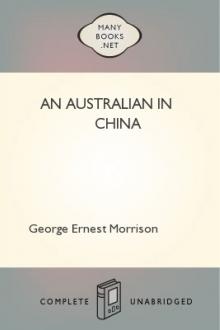Court Life in China by Isaac Taylor Headland (miss read books txt) 📕

- Author: Isaac Taylor Headland
- Performer: -
Book online «Court Life in China by Isaac Taylor Headland (miss read books txt) 📕». Author Isaac Taylor Headland
” ‘Why do you wear blue shoes?’ asked Her Majesty.
” ‘On account of the death of my father,’ replied the Princess.
” ‘And do you mourn over your dead father more than you rejoice over being in the presence of your living ruler?’ the Empress Dowager inquired.
“It is unnecessary to add that the Princess ‘changed the blue shoes for red ones while she remained in the palace, so careful has the Empress Dowager always been of the respect due to her dignity and position.”
Having promised the regency to Prince Chun, we may infer that the Empress Dowager would do all in her power to prepare him to occupy the position with credit to himself, and in the hope that he would continue the policy which she has followed during the last ten years. Whenever, therefore, opportunity offered for a prince to represent the government at any public function with which foreigners were connected, Prince Chun was asked or appointed to attend. I have said that it was the murder of the German minister, Baron von Kettler, that gave Prince Chun his opportunity to see the world. And just here I might add that an account of the massacre of Von Kettler, sent from Canton, was published in a New York paper three days before it occurred. This indicates that his death had been premeditated and ordered by some high authorities,—perhaps Prince Tuan or Prince Chuang, Boxer leaders,—because the Germans had taken the port of Kiaochou, and had compelled the Chinese government to promise to allow them to open all the mines and build all the railroads in the province of Shantung.
After the Boxer troubles were settled, the Germans, at the expense of the Chinese government, erected a large stone memorial arch on the spot where Von Kettler fell. At its dedication, members of the diplomatic corps of all the legations in Peking were present, including ladies and children, together with a large number of Chinese officials representing the city, the government, and the Foreign Office, and Prince Chun was selected to pour the sacrificial wine. He did it with all the dignity of a prince, however much he may or may not have enjoyed it. On this occasion he used one of the ancient, three-legged, sacrificial wine-cups, which he held in both hands, while Na Tung, President of the Foreign Office, poured the wine into the cup from a tankard of a very beautiful and unique design. It is the only occasion on which I have seen the Prince when he did not seem to enjoy what he was doing. I ought to add just here that I have heard the Chinese refer to this arch as the monument erected by the Chinese government in memory of the man who murdered Baron von Kettler!
It is a well-known fact that the Boxers destroyed all buildings that had any indication of a foreign style of architecture, whether they belonged to Chinese or foreigner, Christian or non-Christian, legation, merchant, or missionary. In the rebuilding of the Peking legations, missions, and educational institutions, there were naturally a large number of dedicatory services. Many of the Chinese officials attended them, but I shall refer to only one or two at which I remember meeting Prince Chun. I believe it was the design of the Empress Dowager, as soon as she had decided upon him as the Regent, to give him as liberal an education in foreign affairs as the facilities in Peking would allow.
For many years the Methodist mission had tried to secure funds from America to erect a hospital and medical school in connection with the mission and the Peking University. This they found to be impossible, and finally Dr. N. S. Hopkins of Massachusetts, who was in charge of that work, consulted with his brother and brother-in-law, who subscribed the funds and built the institution. This act of benevolence on the part of Dr. Hopkins and his friends appealed to the Chinese sense of generosity, and when the building was completed, a large number of Chinese officials, together with Prince Chun and Prince Pu Lun, were present at its dedication. A number of addresses were made by such men as Major Conger, the American minister, Bishop Moore, Na Tung, Governor Hu, General Chiang, and others of the older representatives, in which they expressed their appreciation of the generosity which prompted a man like Dr. Hopkins to give not only himself, but his money, for the education of the Chinese youth and the healing of their poor. And I might add that Dr. Hopkins is physician to many of the princes and officials in Peking at the present time.
During this reconstruction, a number of the colleges of north China united to form a union educational institution. One part of this scheme was a union medical college, situated on the Ha-ta-men great street not a hundred yards north of the Von Kettler memorial arch. To the erection of this building the wealthy officials of Peking subscribed liberally, and the Empress Dowager sent her check for 11,000 taels, equal to $9,000 in American gold, and appointed Prince Chun to represent the Chinese government at its dedication. At this meeting Sir Robert Hart made an address on behalf of the foreigners, and Na Tung on behalf of the Chinese. Although Prince Chun took no public part in the exercises, he privately expressed his gratification at seeing the completion of such an up-to-date hospital and medical school in the Chinese capital.
I have given these incidents in the life of Prince Chun to show that he has had facilities for knowing the world better than any other Chinese monarch or regent that has ever sat upon the dragon throne, and that he has grasped the opportunities as they came to him. He has been intimately associated with the diplomatic life of the various legations, which is perhaps the most important knowledge he has acquired in dealing with foreign affairs, as these ministers are the channels through which he must come in contact with foreign governments. He has been present at the dedication of a number of missionary educational institutions, and hence from personal contact he will have some comprehension of the animus and work of missions and the character of the men engaged in that work. He may have as a councillor, if he so desires, the Prince Pu Lun, who has had a trip around the world, with the best possible facilities for seeing Japan, America, Great Britain, Germany, France, and Italy, and who has been in even more intimate contact with the diplomats and other foreigners than has Prince Chun himself. My wife and I have dined with him and the Princess both at the American legation and at his own palace, and when we left China, they came together in their brougham to bid us good-bye, a thing which could not have happened a few years ago, and an indication of how wide open the doors in China are now standing.
On the whole, therefore, Prince Chun begins his regency with a brighter outlook for his foreign relations than any other ruler China has ever had. What shall we say of his Chinese relations? Being the brother of Kuang Hsu, and himself a progressive young man, he ought to have the support of the Reform party, and being the choice of the Empress Dowager, he will have the support of the great progressive officials who have had the conduct of affairs for the last quarter of a century and more, and especially for the past ten years, since the Emperor Kuang Hsu was deposed.
XIIThe Home of the Court—The Forbidden City
The innermost enclosure is the Forbidden City and contains the palace and its surrounding buildings. The wall is less solid and high than the city wall, is covered with bright yellow tiles, and surrounded by a deep, wide moat. Two gates on the east and west afford access to the interior of this habitation of the Emperor, as well as the space and rooms appertaining, which furnish lodgment to the guard defending the approach to the dragon’s throne. —S. Wells Williams in “The Middle Kingdom.”
XIITHE HOME OF THE COURT—THE FORBIDDEN CITY
During the past ten years, since the dethronement of the late Emperor Kuang Hsu, I have often been asked by Europeans visiting Peking:
“What would happen if the Emperor should die?”
“They would put a new Emperor on the throne,” was my invariable answer. They usually followed this with another question:
“What would happen if the Empress Dowager should die?”
“In that case the Emperor, of course, would again resume the throne,” I always replied without hesitation. But during those ten years, not one of my friends ever thought to propound the question, nor did I have the wit to ask myself:
“What would happen if the Emperor and the Empress Dowager should both suddenly snap the frail cord of life at or about the same time?”
Had such a question come to me, I confess I should not have known how to answer it. It is a problem that probably never presented itself to any one outside of that mysterious Forbidden City, or the equally mysterious spectres that come and go through its half-open gates in the darkness of the early morning. There are three parties to whom it may have come again and again, and to whom we may perhaps be indebted both for the problem and the solution.
When the deaths of both of their Imperial Majesties were announced at the same time, the news also came that the Japanese suspected that there had been foul play. With them, however, it was only suspicion; none of them, so far as I know, ever undertook to analyze the matter or unravel the mystery. There is no doubt a reasonable explanation, but we must go for it to the Forbidden City, the most mysterious royal dwelling in the world, where white men have never gone except by invitation from the throne, save on one occasion.
In 1901, while the court was in hiding at Hsianfu, the city to which they fled when the allies entered Peking, the western half of the Forbidden City was thrown open to the public, the only condition being that said public have a certificate which would serve as a pass to the American boys in blue who guarded the Wu men, or front gate. I was fortunate enough to have that pass.
My first move was to get a Chinese photographer—the best I could find in the city—to go with me and take pictures of everything I wanted as well as anything else that suited his fancy.
The city





Comments (0)